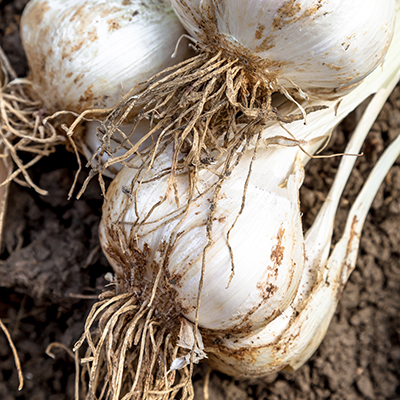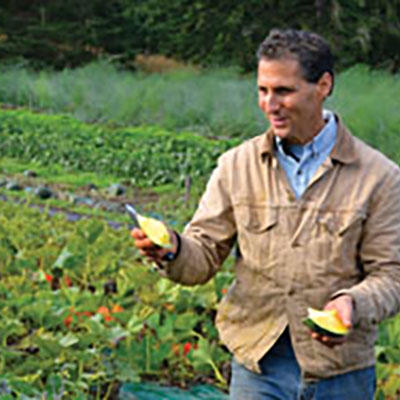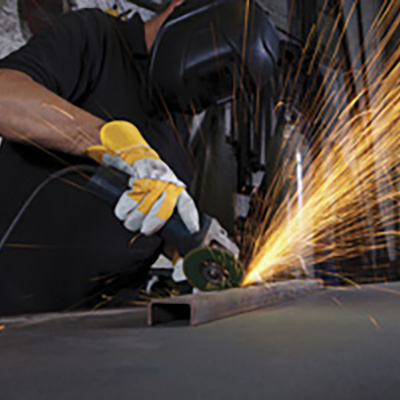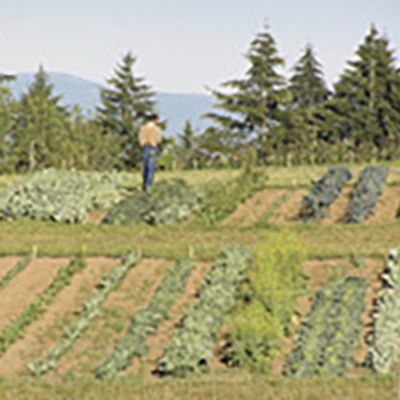In the June/July issue, I wrote about garlic harvest and curing. Everything is connected, of course, and the summer work of cultivation and harvest is tied to the the fall work of planting. Farm scale, markets, and equipment affect planting techniques from one farm to the next. In this article, I’ll tell you how farms of several different sizes get their garlic in the ground.

On my own very small farm, I grow 900 cloves of garlic on beds that are 66” on center, four rows 12” apart. I grow Siberian, which is a hardneck, and an unnamed red softneck. I simply use an SHW row-making hoe (with a narrow pointed side) to open four furrows in the bed and then I press the cloves, root side down, into the bottom of the furrow every 4” before filling the furrow back in. This is tight spacing but I will take the opportunity in spring to harvest half of the crop as green and fresh garlic by thinning every other plant using a sharpened steel transplanting trowel.
The other growers I talked to for this article grow many varieties of garlic both for market and to sell for seed. Chet Byler at Straw Hat Farm in Montrose, Colorado, hand plants on very tight 6” rows that he marks with a tool he made from Earthway press wheels, a bit of all thread rod, and pipe nipples for spacers. Chet is planting 70,000 cloves in a season. His row marker can also be used for other crops and, with different sized nipples, he can change the spacing depending on the crop. In line, he is also planting at roughly 6”, following the faint marks left by the ribs on the wheels.
On a slightly smaller scale, Avram Drucker of Garlicana in Southern Oregon uses a dibbling plate to set his spacing. His dibbler marks multiple rows as well as several in-line plants all at once, although he is switching to a design that friends of his use on their farm in New Mexico, which only marks one row across the bed at a time. The one-row tool is much lighter and easier to use.
Fred Forsburg of Honeyhill Farm and Ed Fraser of Fraser’s Garlic Farm, both in New York State, have grown several acres of garlic for seed, direct markets, and wholesale markets for many years. They prefer much wider spacings, planting just two rows on similar width beds, with 30” or 38” spacing between the rows to suit their particular cultivating tractors and implements. Fred plants about 40,000 cloves and Ed plants about 150,000 cloves in a season. Fred got a SARE grant to develop a planting platform that he is continuing to refine, but is very simple in its design. Search SARE for project FNE11-717 for more information on Fred’s project. The basic concept is that the workers and their containers of seed sit on the platform and plant through holes in the platform of the trailer. The tractor that is pulling the trailer is also opening furrows making it easy to plant deeply and in a straight line. The furrows are then filled in with a hiller on the Platform’s toolbar or second pass of the cultivating tractor. The tractor’s hydrostatic transmission allows it to move about 4” a second.
At Eatwell Farm in California, a similar trailer has shanks for marking rows mounted on the sled itself. It also would be easy to mount sweeps behind to fill the furrow as it is planted. Using the tractor to plant speeds things up and, perhaps more significantly, is far more ergonomic, relieving the normal back pain from bending over and dragging a bucket of seed garlic. 
The sled/trailer type planting aid allows the cloves to be carefully placed with the root plate down, which most growers find important for well-shaped garlic heads, especially with hardneck varieties. Ed also uses a two row ERME bulb planter for tightly spaced softneck garlic that he sells as green and fresh garlic. For that garlic, he doesn’t mind if the cloves are planted on their side, or even occasionally upside down. Ed uses Fred’s platform for some of his planting.
“I also ride on an old New Idea transplanter depending on availability of labor and if I am planting a single row on the 38” spacing,” Ed said. “Just another option for people. There are many farmers now experimenting with planting into plastic mulch on a raised or flat bed. The results have been very good and I may try some of that this year.”
I visited a larger farm here in Oregon a number of years ago that had developed its own garlic planter. It was also a trailer-type arrangement, but it had platforms for two people to stand on with a kind of sorting tray for each of them. They would then slide garlic seed to a slot in the side of the tray where it would fall onto a small conveyor. The conveyor had marks to space the garlic and the conveyor then dropped the seed down a tube and into a furrow that was opened by a shoe, and then closed behind. The spacing was quite tight in the row, but there were also only two rows on a fairly wide bed, which gave good air flow in the canopy and space for the roots to spread.
All of these planters are similar to potato planting set-ups, and the simpler ones could easily do double duty, with minor modifications, for row spacing, furrow depth and in-row spacing.
Popping seed
Separating garlic bulbs into cloves is known as “popping” garlic. All of the growers I talked to pop seed by hand. Some like to use butter knives or plastic scrapers to help get between tight cloves. I’ve always had success with just my hands, but it does help to have good finger strength. Ed described to me a device a friend has that is basically a cone which the top of the garlic is pressed against to split apart the entire head at once. Generally, while popping the cloves they are also being sized. Large cloves are used for full-size garlic bulbs and small cloves for green garlic, which is pulled early and used like chives or green onions.
Several pests and diseases can be spread by seed garlic. In New York there have been serious problems with garlic bloat nematode, which came in from Canada on table garlic that was then likely used for seed stock, which has continued to spread the problem around. In Colorado, Chet had heard of the problem but had not seen it there, and was sending samples of seed to be tested. In the Northwest, Avram is more concerned with bulb mites and fusarium. For those problems he soaks his seed in 10% bleach for 10 minutes and then deactivates the bleach by rinsing the seed in a bucket of hot water. He also mentions hot water or rubbing alcohol are alternative treatments. He dries the seed completely before planting. Ed Fraser cautions that any hot water treatment should be done in a controlled manner because garlic seed can be killed by water above about 120°F. In any case, he says, there are many disease problems plaguing the industry at present.
“We are seeing infestations of wheat curl mites, fusarium bulb rot, white rot, botrytus and a few others. People should be purchasing seed stock from a source that has laboratory testing done. This would really help to curtail the spread of some of these diseases. We regularly test what we grow and what we handle that is sold to the public. It makes for a much happier customer.”
Cultivation
The planting method has some impact on the tools used for cultivation as does the choice to mulch or not mulch. Mulching is common practice on many farms, especially when garlic is grown on a smaller scale. I’ve worked on several farms that usedleaves for mulching, as the leaf collection season corresponds well to garlic planting season. Leaves are an excellent weed suppressant that don’t harbor weed seeds. Friends at Persephone Farm in Lebanon, Oregon, told me that for many years they were able to get weed-free straw in big round bales that they were able to simply roll out in the field to cover the planting, a relatively low labor way to spread mulch without a tractor. If the straw has any quantity of seed remaining, or has significant weed seeds, it can create a weed problem in the field. Once the mulch is down it is impossible to use tractors or even hoes to cultivate out weeds so it’s important that the mulch is weed-seed-free and that a thick layer is applied.

Because of the cost and labor involved with mulch, many farmers, myself included, choose to leave the soil bare, allowing cultivation with flame and steel through the garlic growing season. Fred Forsburg uses the standard corn cultivating implements on his Allis Chalmers CA to cultivate his two-row garlic. He has also used vinegar to kill weeds and his SARE report on that method is available on his website -honeyhillorganicfarm.com.
Ed Fraser varies his cultivation regimen depending on the weather and access to the fields with equipment. He uses some steel, but also vinegar, as well as flame to control weeds in the garlic. He uses flame even when the garlic is up to a foot tall. Carrying a large tank of propane on the tractor but walking with a hand wand from Flame Engineering next to the tractor, he is able to point the flame at the side of the plant, killing weeds in a 6” wide band next to the plant and in the row. He passes down each side of each rows, typically in early April, and sometimes making a second pass later in the season depending on weed pressure and his ability to get into the field with hilling disks or knives. The flame does a little damage to the outside leaves, but the hard cuticle of the garlic and the well-protected growing tip shield the plant from any significant damage from the flame.
Similarly, for years I flamed my garlic plantings when they were 1-4” out of the ground and winter weeds were still small. I mostly gave up flaming in favor of cultivating with a Lely tine weeder, which in light soils can be used until garlic is at least 6-8” tall. Cultivation with the tines also helps open up the rain-compacted soil here in the Northwest when we have a window of dry weather. A drawback to not mulching is exposing significant soil surface area to winter weather as the garlic canopy doesn’t really fill in until April.
On a hand scale, I use a four-tine cultivator with an effect similar to the tine weeder. The cultivator loosens soil that is too wet to get a hoe through. I also use a Heron hoe from Holdridge Enterprises which was actually developed with garlic in mind. The stainless blade that cuts with both forward and backward motions is much less prone to clogging in our wet springs and stays usably sharp with no real maintenance. With a few well-timed cultivations in late fall and mid winter I can keep the garlic nearly weed free. Chet, with his tight spacing, uses another favorite tool of mine, the 4” colinear hoe from Johnny’s Selected Seeds.














